Below is a review article from Blake McNeil (a customer) who posts on reddit https://www.reddit.com/r/wok/comments/19aptbd/outdoorstirfry_buner_6b_comparison/. As of January 2024, PowerFlamer propane 160 stoves utilize two burners: one 5 inches (5B) in PowerFlamer propane 160 manual PF13x160, electronic ignition PF13x160EI and one 6 inches (6B) in PowerFlamer propane 160 integrated ignition PF13x160IEI. We ask the customer to do the comparison. Below is his review.
I use my PowerFlamer Propane 160 wok burner from OutdoorStirfry a LOT, it is my principal cooking
device in my home. Stir fry, steamer or even just boiling up water for spaghetti (why use a piddly little
stove burner when you have Godzilla sitting outside?) my wok burner is usually what I cook on. Even in
the depths of a Canadian winter, you can find me cooking outside on my wok burner. -30C, no problem
the PowerFlamer has the jam to do it right no matter how cold it might be.
When I saw that there was a new burner coming out for the PowerFlamer I asked if I could get one and
compare it to the existing burner, these are my findings, but first some background. My ascent into
Asian cooking came about as I wanted to increase my veggies and reduce my meat intake. Being retired I
need to pay more attention to my diet after years of abuse running various startup companies which left
little time for a healthy diet. I suffered from veggie boredom eating the traditional North American fair
and switch to an Asian diet where the endless combinations of veggies and sauces put an end to veggie
boredom. I started cheap and got an Eastman Kahuna Burner and while it was a big step up from wimpy
stove cooked stir fry, it is not a real wok burner. It focuses all its heat on a very small area and isn’t
designed for a wok. Heat management is problematic if you are cooking for more than one person as it
creates a small intense hot spot that easily burns food while the rest of the wok isn’t very hot. Trying to
mitigate this small hot spot I use a 14” carbon steel Yosukata round bottom Wok which dissipated the
heat a bit but it is a heavier wok so I tend to use a Chao technique (more stirring than tossing of a Bao
technique). Use of a Chao technique was also because the Kahuna Burner doesn’t lend itself to moving
the wok as it isn’t very stable and doesn’t have a wok ring.
Once the welds on the Kahuna Burner started to fail, it was time to step up and the search was on for a
‘real’ wok burner for a home user. Enter OutdoorStirfry, a real wok burner, complete with a wok ring
and when I saw the available stand, it was take my money time. The upgrade to the PowerFlamer from
the Kahuna Burner was a bigger upgrade than from the stove top to the Kahuna Burner. The
PowerFlamer allowed me to up my game and flavor big time. Far better control and a far bigger sweet
spot than the Kahuna Burner. When the new burner came out, I was very interested as to what a new
burner could improve upon.
I bought my PowerFlamer with a manual pilot light ignition system as I thought that would work better
for me than an electronic ignition, so to swap in the new burner I got just the 6B burner with no ignition
system and would swap it with my existing burner.
There are some physical differences between the burners. The 6B is bigger and has more flame jets than
the old burner and more significantly over a larger area.
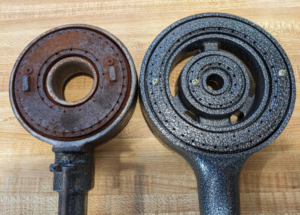
Disassembling my old burner.
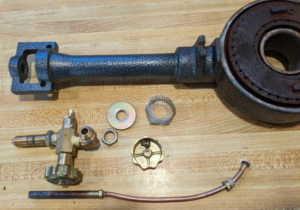
Then reassembled it using the new 6B burner. The 6B burner fits all the mounting holes etc, but a couple
of things you will notice. First the 6B is longer which means my pilot flame tube comes up a little short,
not a real problem but something to note.
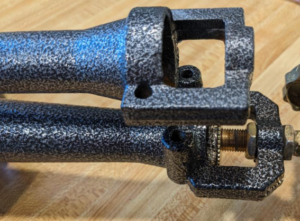
The other thing you will notice is the new burner has a slightly narrower throat so you will need to neck
down the screen to fit.
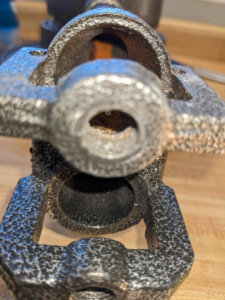
These were the only things I found, otherwise the upgrade was pretty much trivial. NOTE I can’t speak
for the electronic ignition systems, but I suspect they can also be converted but not the length change as
that might be a concern.
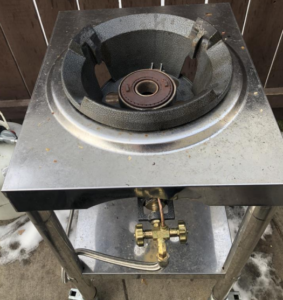
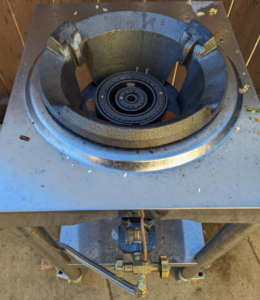
Performance changes. I did a bunch of tests boiling water and such but really those show that both
burners boil water just fine, but with the old burner you can see there are two heat zones. First at the
bottom of the wok and then part way up the side of the wok, where the boiling begins indicating a
higher heat in these regions.

With the new burner the entire wok starts to boil at the same time. This indicates a far more consistent
heat distribution with the new 6B burner. This is very significant as stir fry is the movement of food in
and out of heat zones and the smaller the hot zone the harder it is not to burn food or get a consistent
cooking of food. This larger more consistent heating will also allow me to be even more aggressive with
heat as I’ll have a higher percentage of food in the hot zone and will be able to cook even faster and
capture more wok hei than before. I should mention that I’m cooking for a family so my portion sizes
border on overloading the wok, so the more consistent heating is huge for me in getting a consistent
cooking of my dishes. One other problem with small but intense hot spots is an increase in what is call
‘wok poo’, burnt carbonized food (sugars, starches etc) on the hot spot. When you wipe your wok when
your done and it comes up black then you might have wok poo problem. Having a larger sweet spot and
a more consistent heating of the wok will reduce burning and hence wok poo, your wok will be easier to
clean.
At the end of my testing, which burner am I going with, definitely the new 6B burner.
After some uses including woking a cabbage, carrot, lotus root and beef stir fry at –33C with a –44C wind
chill during a polar vortex (I use my burner all year long here in Calgary), this burner is deceptively
powerful. You don’t need a flame licking your eyebrows to cook on, since there are more gas jets, I’d
recommend starting a bit lower flame than your old setting to cook on and working up from there.
Blake has another post “Got a wok burner, get a steamer” at https://www.reddit.com/r/wok/comments/19bnw74/got_a_wok_burner_get_a_steamer/. White steams come up surrounded by white snow, quite a scene.
